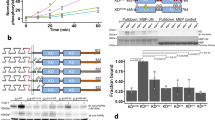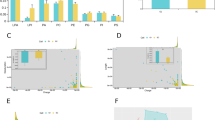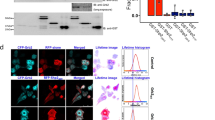Abstract
STIMULATION of growth factor receptors with tyrosine kinase activity is followed by rapid receptor dimerization, tyrosine autophosphorylation and phosphorylation of signalling molecules such as phospholipase Cγ(PLCγ) and the ros GTPase-activating protein1,2. PLCγ and GTPase-activating protein bind to specific tyrosine-phosphorylated regions in growth factor receptors3–9through their sir-homologous SH2 domains7,8,10,11. Growth factor-induced tyrosine phosphorylation of PLCγ is essential for stimulation of phosphatidylinositol hydrolysis in vitro12 and in vivo13. We have shown that a short phosphorylated peptide containing tyrosine at position 766 from a conserved region14–18 of the fibre-blast growth factor (FGF) receptor is a binding site for the SH2 domain of PLCγ (ref. 8). Here we show that an FGF receptor point mutant in which Tyr766 is replaced by a phenylalanine residue (Y766F) is unable to associate with and tyrosine-phosphorylate PLCγ or to stimulate hydrolysis of phosphatidylinositol. Nevertheless, the Y766F FGF receptor mutant can be autophos-phorylated, and can phosphorylate several cellular proteins and stimulate DNA synthesis. Our data show that phosphorylation of the conserved Tyr 766 of the FGF receptor is essential for phosphorylation of PLCγ and for hydrolysis of phosphatidylinositol, but that elimination of this hydrolysis does not affect FGF-induced mitogenesis.
This is a preview of subscription content, access via your institution
Access options
Subscribe to this journal
Receive 51 print issues and online access
$199.00 per year
only $3.90 per issue
Buy this article
- Purchase on SpringerLink
- Instant access to full article PDF
Prices may be subject to local taxes which are calculated during checkout
Similar content being viewed by others
References
Ullrich, A. & Schlessinger, J. Cell 61, 203–212 (1990).
Cantley, L. C. et al. Cell 64, 281–302 (1991).
Wahl, M. I., Nishibe, S., Suh, P.-G., Rhee, S. G. & Carpenter, G. Proc. natn. Acad. Sci. U.S.A. 86, 1568–1572 (1989).
Meisenhelder, J., Suh, P.-G., Rhee, S. G. & Hunter, T. Cell 57, 1109–1122 (1989).
Margolis, B. et al. Cell 57, 1101–1107 (1989).
Burgess, W. H. et al. Molec. cell. Biol. 10, 4770–4777 (1990).
Margolis, B. et al. EMBO J. 9, 4375–4380 (1990).
Mohammadi, M. et al. Molec. cell. Biol. 11, 5068–5078 (1991).
Kaplan, D. R., Morrison, D. K., Wong, G., McCormick, F. & Williams, L. T. Cell 61, 125–133 (1990).
Koch, C. A., Anderson D., Moran, M., Ellis, C. & Pawson, T. Science 252, 668–674 (1991).
Anderson, D. et al. Science 250, 979–982 (1990).
Nishibe, S. et al. Science 250, 1253–1255 (1990).
Kim, H. K. et al. Cell 65, 435–441 (1991).
Lee, P. L., Johnson, D. E., Cousens, L. S., Fried, V. A. & Williams, L. T. Science 245, 5760 (1989).
Ruta, M. et al. Oncogene 3, 9–15 (1988).
Kornbluth, S., Paulson, K. E. & Hanafusa, H. Molec. cell. Biol. 8, 5541–5544 (1988).
Keegan, K., Johnson, D. E., Williams, L. T. & Hayman, M. J. Proc. natn. Acad Sci. U.S.A. 88, 1095–1099 (1991).
Dionne, C. A. et al. EMBO J. 9, 2685–2692 (1990).
Kumjian, D. A., Wahl, M. I., Rhee, S. G. & Hunter, T. Proc. natn. Acad. Sci. U.S.A. 86, 8232–8239 (1989).
Morrison, D. K., Kaplan, D. R., Rhee, S. G. & Hunter, T. Molec. cell. Biol. 10, 2359–2366 (1990).
Kumjian, D. A., Barnstein, A., Rhee, S. G. & Daniel, T. O. J. biol. Chem. 266, 3973–3980 (1991).
Margolis, B. et al. Science 248, 607–610 (1990).
Cuadrado, A. & Molloy, C. J. Molec. cell. Biol. 10, 6069–6072 (1990).
Sultzman, L., Ellis, C., Lin, L-L., Pawson, T. & Knopf, J. Molec. cell. Biol. 11, 2018–2025 (1991).
Smith, M. R., Liu, Y.-L., Kim, H., Rhee, S. G. & Kung, H.-F. Science 247, 1074–1077 (1990).
Smith, M. R., Ryu, S.-H., Suh, P. G., Rhee, S. G. & Kung, H. F. Proc. natn. Acad. Sci. U.S.A. 86, 3659–3663 (1989).
Molloy, C. J. et al. Nature 342, 711–714 (1989).
Downing, J. R. et al. EMBO J. 8, 3345–3350 (1989).
Paterno, G. D., Gillepsie, L. L., Dixon, M. S., Slack, J. M. W. & Heath, J. K. Development 106, 79–83 (1989).
Amaya, E., Musci, T. J. & Kirschner, M. W. Cell 66, 257–270 (1991).
Berridge, M. J., Downes, C. P. & Hanley, M. J. Cell 59, 411–419 (1989).
Goldschmidt-Clermont, P. J., Kim, J. W., Machesky, L. M., Rhee, S. G. & Pollard, T. D. Science 251, 1231–1233 (1991).
Jaye, M., Lyall, R. M., Mudd, R., Schlessinger, J. & Sarver, N. EMBO J. 7, 963–969 (1988).
Chen, C. & Okayamad H. Molec. cell. Biol. 7, 2745–2752 (1987).
Author information
Authors and Affiliations
Rights and permissions
About this article
Cite this article
Mohammadi, M., Dionne, C., Li, W. et al. Point mutation in FGF receptor eliminates phosphatidylinositol hydrolysis without affecting mitogenesis. Nature 358, 681–684 (1992). https://doi.org/10.1038/358681a0
Received:
Accepted:
Issue Date:
DOI: https://doi.org/10.1038/358681a0
This article is cited by
-
Metabolic Messengers: fibroblast growth factor 1
Nature Metabolism (2022)
-
Neural stem cells secrete factors facilitating brain regeneration upon constitutive Raf-Erk activation
Scientific Reports (2016)
-
Fibroblast Growth Factor Signaling in the Vasculature
Current Atherosclerosis Reports (2015)
-
Profiling and semiquantitative analysis of the cell surface proteome in human mesenchymal stem cells
Analytical and Bioanalytical Chemistry (2013)
-
Molecular genetic analysis of FGFR1 signalling reveals distinct roles of MAPK and PLCγ1 activation for self-renewal of adult neural stem cells
Molecular Brain (2009)



